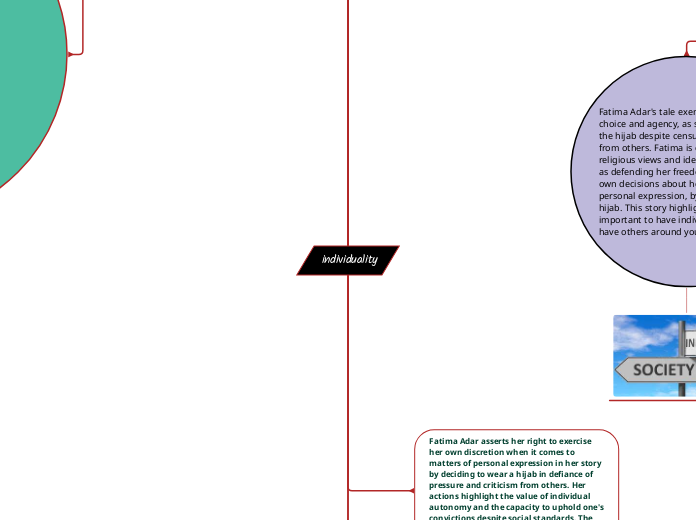individuality
The pedestrian
Mead is the essential character in this story. He is particular from the rest of society since he values confinement and freedom. He could be a outcast since he denies to comply to society's standards. He does not, be that as it may, provide up his identity since it may be a component of what makes him human.

In the end, Mead is arrested and taken away for his "crime" of walking alone at night. This represents the harsh consequences that individuals can face for challenging societal norms and standing out from the crowd. The story serves as a warning against the dangers of conformity and the importance of valuing and preserving individuality.
The Setting is important in Ray Bradbury's novel "The Pedestrian" in depicting personality. The tale is set in a futuristic society in which the government has established a rigid and repressive system that removes personality and innovation. The location represents this oppressive society, and the juxtaposition between the character's individuality emphasizes the significance of maintaining one's individuality. The streets are deserted, and the structures are all the same.

"The Pedestrian" by Ray Bradbury is set in a dystopian society that values conformity over individuality. The character Mead stands out because he values freedom and refuses to conform, leading to his arrest. The story serves as a warning against the dangers of conformity and the importance of preserving individuality. The setting of the deserted streets and identical buildings emphasizes the oppressive nature of the society."
Heavy Scarves
Fatima Adar's tale exemplifies individual choice and agency, as she chose to wear the hijab despite censure and judgement from others. Fatima is expressing her religious views and identification, as well as defending her freedom to make her own decisions about her appearance and personal expression, by wearing the hijab. This story highlights why its important to have individuality and not have others around you decide for you.
Fatima receives a variety of reactions from her classmates and even has inner conflicts with herself. Despite the pressure, Fatima sticks to her decision to wear the hijab and eventually solves her conflict herself.
Fatima's actions show that people have the ability to make their own decisions and stick up for their views, even in the face of social pressures and expectations. She is expressing her own agency and confronting prevailing narratives that can sometimes determine how people should show themselves by wearing the headscarf. Fatima's tale is a powerful illustration of human individuality and agency in this manner.
Fatima Adar asserts her right to exercise her own discretion when it comes to matters of personal expression in her story by deciding to wear a hijab in defiance of pressure and criticism from others. Her actions highlight the value of individual autonomy and the capacity to uphold one's convictions despite social standards. The tale of Fatima serves as a potent example of human freedom and decision-making.
"Harrison Bergeron" by Kurt Vonnegut depicts a society where everyone is forced to be equal through government-imposed handicaps. The protagonist, Harrison, stands out for his intelligence and athleticism but is determined to express his uniqueness even if it means disobeying the government. The story argues for the importance of allowing individuals to express themselves freely and the negative consequences of suppressing individuality in a society.
Harrrison Begeron
Kurt Vonnegut, Jr.'s apocalyptic short tale "Harrison Bergeron" depicts a society in which everyone is compelled to be equal. Individuals in this society are robbed of their distinct traits and abilities through the use of government-imposed handicaps. Individuality is represented in the tale by demonstrating the repercussions of suppressing it.

Harrison Bergeron is the protagonist of the tale, a young man who is extremely bright and athletic but is hampered by the government to ensure that he is no better than anyone else. Harrison is portrayed as a unique person who refuses to adhere to the government's requests for sameness and uniformity, and he is determined to express his uniqueness even if it means disobeying the government.

Furthermore, the story implies that individuals have a right to their own uniqueness and that this uniqueness is an essential part of what makes us human. By showing the negative consequences of a society that suppresses individuality, Vonnegut makes a case for the importance of allowing individuals to be who they are and to express themselves freely.

Traplines
Christopher's Decision

The Fishing trip

The moment where Thomas King gives his son a fishing box that his father gave to him in the short tale "Trapline" represents individuality in a number of ways. On the one hand, the tin represents a feeling of custom and continuity within the family and is a family treasure that has been handed down through the centuries. It highlights the value of uniqueness and personal legacy and reflects the author's wish to impart his opinions and experiences to future generations. Last but not least, the fishing's case itself is distinctive and represents the author's preferences and styles. It highlights the value of unique ingenuity and expression. The scenario serves as a metaphor for the notion that tradition and personal experience can both have an impact on one's personality and sense of self.

The absence of contact between Thomas King's father and himself serves as a complex representation of individuality in "Traplines" by Thomas King. First of all, it emphasizes how distinct events and viewpoints that each character has shaped their communication methods. While the author himself is more outgoing and expressive, the author's father is depicted as being emotionally closed off and unable to articulate his emotions. The notion that uniqueness is not just about one's personality but also about the events that influence their behavior's is highlighted by this difference.
